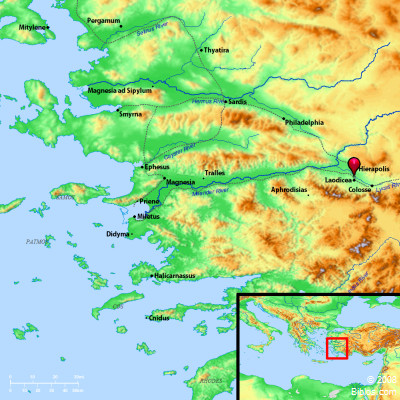Atlas  Laodicea and surrounding region Maps Created using Biblemapper 3.0 Additional data from OpenBible.info Occurrences Colossians 2:1 For I desire to have you know how greatly I struggle for you, and for those at Laodicea, and for as many as have not seen my face in the flesh;Colossians 4:13 For I testify about him, that he has great zeal for you, and for those in Laodicea, and for those in Hierapolis. Colossians 4:15 Greet the brothers who are in Laodicea, and Nymphas, and the assembly that is in his house. Colossians 4:16 When this letter has been read among you, cause it to be read also in the assembly of the Laodiceans; and that you also read the letter from Laodicea. Revelation 1:11 saying, " What you see, write in a book and send to the seven assemblies : to Ephesus, Smyrna, Pergamum, Thyatira, Sardis, Philadelphia, and to Laodicea." Revelation 3:14 "To the angel of the assembly in Laodicea write: "The Amen, the Faithful and True Witness, the Head of God's creation, says these things: Encyclopedia LAODICEAla-od-i-se'-a (Laodikia): A city of Asia Minor situated in the Lycos valley in the province of Phrygia, and the home of one of the Seven Churches of Re (1:11). Distinguished from several other cities of that name by the appellation Ad Lycum, it was founded by Antiochus II (261-246 B.C.) of Syria, who named it for his wife Laodike, and who populated it with Syrians and with Jews who were transplanted from Babylonia to the cities of Phrygia and Lydia. Though Laodicea stood on the great highway at the junction of several important routes, it was a place of little consequence until the Roman province of Asia was formed in 190 B.C. It then suddenly became a great and wealthy center of industry, famous specially for the fine black wool of its sheep and for the Phrygian powder for the eyes, which was manufactured there (compare Revelation 3:18). In the vicinity was the temple of Men Karou and a renowned school of medicine. In the year 60 A.D., the city was almost entirely destroyed by an earthquake, but so wealthy were its citizens that they rejected the proffered aid of Rome, and quickly rebuilt it at their own expense (compare Revelation 3:17). It was a city of great wealth, with extensive banking operations (compare Revelation 3:18). Little is known of the early history of Christianity there; Timothy, Mark and Epaphras (Colossians 1:7) seem to have been the first to introduce it. However, Laodicea was early the chief bishopric of Phrygia, and about 166 A.D. Sagaris, its bishop, was martyred. In 1071 the city was taken by the Seljuks; in 1119 it was recovered to the Christians by John Comnenus, and in the 13th century it fell finally into the hands of the Turks. LAODICE'A, now Eski-hissar, " old castle" a little village surrounded by the ancient ruinssituated in Asia Minor, in Phrygia, 86 ms. e. of Ephesus, 46 s.e. of Philadelphia, 554 ms. n.w. from Jerusalem. Strong's Greek G2993: LaodikeiaLaodicea, a city in Phrygia |



